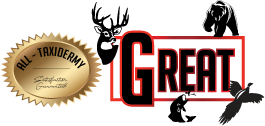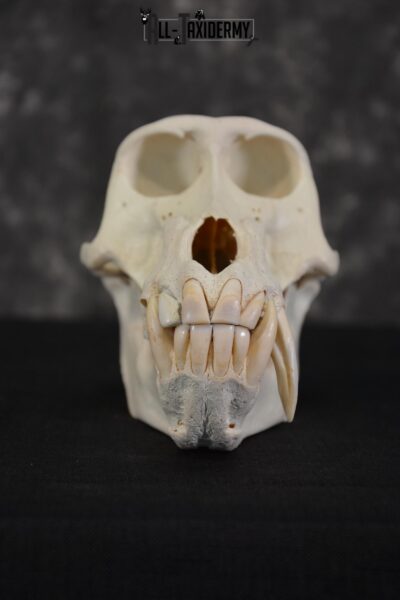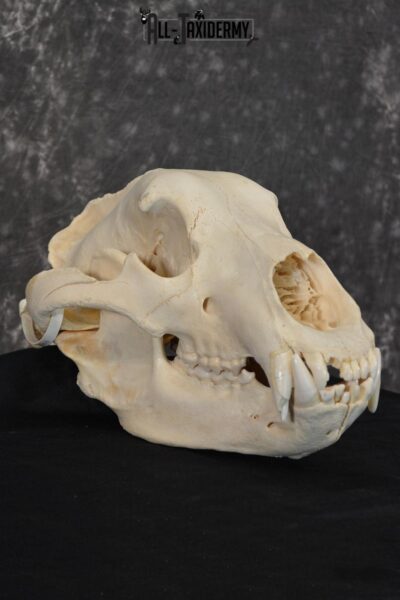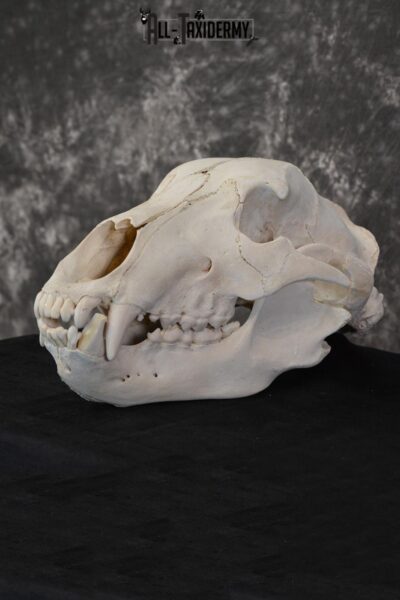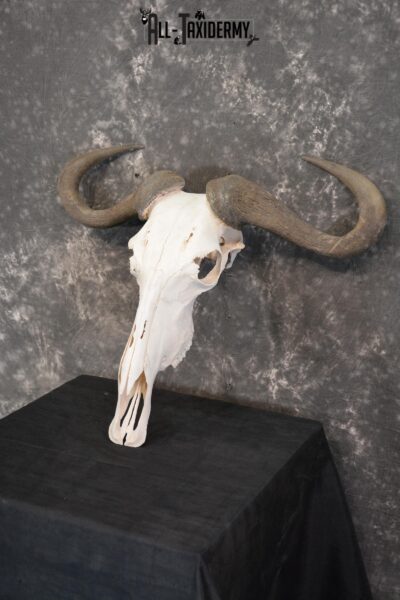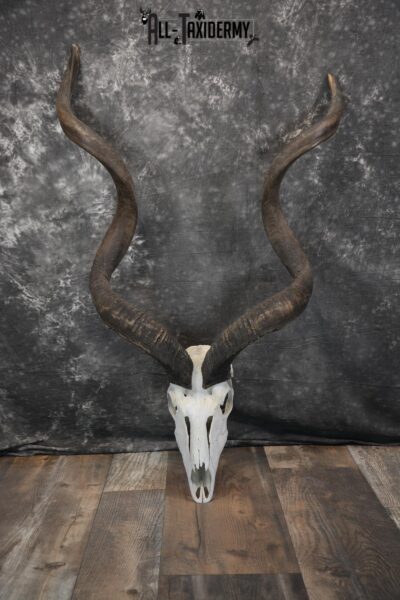

 SOLD
SOLDMonster ... Read More
African Warthog Skull taxidermy for sale SKU 1557
-
View Details
 SOLD
SOLDCollectable ... Read More
African Baboon Skull Taxidermy for sale SKU 1482
-
View Details
 SOLD
SOLDMust for Collectors ... Read More
African Hippopotamus Skull Novelty Taxidermy for sale SKU 1501
-
View Details
 SOLD
SOLDSCI Score 24 6/16 ... Read More
Brown Bear European Skull Taxidermy for sale SKU 1532
-
View Details
 SOLD
SOLDSCI Score 22 8/16 ... Read More
Russian Brown Bear Skull Taxidermy Mount for sale SKU 1533
-
View Details
 SOLD
SOLDAll Teeth ... Read More
Alaska Grizzly Bear Skull Taxidermy for sale SKU 1494
-
View Details
 SOLD
SOLDSCI score 66 1/8 ... Read More
African Black Wildebeest Skull taxidermy for sale SKU 1480
-
View Details
 SOLD
SOLDSCI Score 76 4/8 ... Read More
Blue Wildebeest Taxidermy skull for sale SKU 1462
-
View Details
 SOLD
SOLDSCI Trophy Score 65 7/8 ... Read More
African Red Hartebeest taxidermy skull for sale SKU 1461
-
View Details
 SOLD
SOLDFor Must Collector ... Read More
African Hippopotamus Skull Taxidermy for sale SKU 1479
-
View Details
 SOLD
SOLDGreat Skull SCI 122 1/8 ... Read More
African Greater Kudu Skull taxidermy for sale SKU 1478
-
View Details
 SOLD
SOLDSCI Score 140 3/8 ... Read More
Whitetail Deer antler skull cap 8 pointer for sale SKU 1419
-
View Details
 SOLD
SOLDSCI score 115 7/8 ... Read More
Whitetail Skull cap taxidermy 10 point SKU 1444
-
View Details
 SOLD
SOLDDécor ... Read More
Whitetail Skull cap taxidermy 8 pointer SKU 1445
-
View Details
 SOLD
SOLDSCI score 254 1/8 ... Read More
Red Stag European skull taxidermy mount SKU 1438
-
View Details
 SOLD
SOLD8 Pointer ... Read More
Whitetail Deer 8 point Taxidermy skull cap with hair SKU 1441
-
View Details
 SOLD
SOLD5 pointer ... Read More
Whitetail Deer Skull Cap, Antler Mount Taxidermy with Hair SKU 1442
-
View Details
 SOLD
SOLDDecor ... Read More
Whitetail 7 point skull SKU 1429
-
View Details
Animal Skulls/Bones/Teeth/Tusk
Animal Skulls for Sale
Own a museum, store, office, or nature center? All-Taxidermy is your source for both real and reproduction skulls, horns, antlers, tusks, and more for display. You’ll notice that our real skulls may have the Deluxe Beetle Cleaned Skulls logo, which indicates our most pristine, museum-ready, beetle-cleaned skulls that we have in our inventory. These skulls have been professionally cleaned using the Dermestid beetle skull cleaning method. All our real and reproduction animal skulls are ethically sourced and legally-obtained or reproduced.
Animal Skulls
All-Taxidermy’s animal skulls range from huge pachyderms like the elephant, hippo, and rhino; to big cats like lions, leopards, tigers and cougars; to antelope and deer; to small mammals. Many of these are real, beetle cleaned skulls, and others are reproductions. Every skull’s quality is denoted by our quality grade, ranging from Fair to Superior and Trophy (our most museum-quality skulls).
Animal skulls you can expect to find on our website include: whitetail deer, mule deer, black bear, Grizzly bear, cougar, lynx, pronghorn antelope, Texas longhorn, alligator, giraffe, warthog, African lion, African leopard, Bengal tiger, impala, wildebeest, baboon, zebra, Cape buffalo, and more. Each one of our deer and antelope will include SCI score information in the listing. Please note: Some species listed here are Cities protected and will only be sold to Wisconsin residents.
Replica Skulls
Our replica or reproduction skulls, while not the actual thing, can be shipped anywhere with no regulations. They are perfect for displaying in your office or along with your other skulls/taxidermy collection. Additionally, they are also great for educational purposes such as museum exhibitions and nature centers. Our replica skulls are extremely detailed since they are cast from a real skull. We sell replica skulls for big cats like the Bengal tiger, African lion, and African leopard; as well as the African elephant. Browse all our replica animal skulls here.
European Mounts
Let’s say, for example, you hunt and harvest a mature buck every year. After a while, that can get quite costly. As a result, many hunters opt for at least one shoulder or life size mount, and then consider European mounts as another option for subsequent bucks. Since European mounts are quicker to prepare, you won’t have to wait for many months until you get to see the finished result. By comparison, a shoulder or life size mount will often be finished by the spring, when you shot your buck in the fall.
Are you a hunter wanting to get your animal skull mounted? One of taxidermy enthusiasts’ most popular options is to have their deer, elk, or other big game prepared and made into a European mount. Thanks to a cheaper pricetag, quicker turnaround time, the skull taking up less room, and overall cleaner look (with a focus on the pristine white skull and beautiful antlers/horns!), hunters and taxidermy enthusiasts will more than likely enjoy the European mount as an alternative. Take a look at our guide to European mounts here for more info.
Bones
This category also includes real and replica bones for display. A cool example of a bone that we sold was a real metacarpal leg bone from an African giraffe. Animal bones, especially larger ones, are perfect for display on your mantle, bookshelf, TV set, or in a museum or nature center exhibition. For something even more unique, you may even find bones with a intricate carving in them.
Antlers/Horns
Although we do have our separate antlers and horns category, you’ll also see some of our deer, antelope, sheep, and other ungulates’ skull and antlers/horns here. From larger species of African antelope, to smaller deer or gazelle, we have a wide range of antlers and horns from animals native to North America, Asia, Europe, and Africa. If you’re looking to conserve on space, antlers and horns (and/or the skull) is a perfect way to conserve on space for your growing taxidermy collection.
Teeth/Tusks
Look no further than All-Taxidermy for pristine white teeth and tusks from various species of animals! These are either real or reproduction teeth and tusks from animals such as the African elephant, warthog, and boar. Some of our teeth and tusk displays are small, making them a good choice for your office desk or other small space. Others, such as our huge pair of reproduction elephant tusks, will make a magnificent focal point for your African taxidermy collection!
Animal Skulls FAQs
How to clean animal skulls?
There are several techniques to clean animal skulls, however, we highly recommend choosing dermestid beetle cleaning to help keep the skull fully intact. The first step to dermestid beetle cleaning is the preparation process. You’ll first start by removing as much flesh as you can manually from the skull. The less flesh there is on the skull, the faster the beetles will finish their job. Next, add the beetles to skull. Once they have finished, remove the skull from the colony and clean it gently with warm water to remove any remaining beetle waste or small bits of flesh. Next are the degreasing and whitening processes. Degreasing involves soaking the skull in a mixture of warm water and adding a degreasing soap to help remove fats. Lastly, to whiten the skull, use a hydrogen peroxide solution. Avoid using bleach as it can damage the bone.
How to preserve animal skulls?
There are several methods to cleaning and preserving animal skulls. Prior to starting the process, you should thoroughly wash your hands and put on gloves and a surgical mask. This is to avoid possibility of transmitted diseases. Next is to macerate the skull (another alternative is dermestid beetle cleaning, as detailed above). Macerating the skull involves 1.) cold water maceration, by allowing the skull to soak in cold water with laundry detergent for a few days or up to several weeks, depending on the size of the skull; or 2.) hot water maceration, which involves putting the skull in hot water with enzyme detergent, (without boiling it). Following the maceration or beetle cleaning process, next is removing the grease using latex gloves, water, and dish detergent. Lastly, dry the skull and use a hydrogen peroxide solution. Although some use chlorine bleach, we highly recommend that you don’t as that can damage the bone and teeth.
How to identify animal skulls?
To identify animal skulls, it will require taking into account its size, shape, dentition, and other distinctive characteristics. The overall size and shape of the skull can help narrow down what type of animal it might be. For instance, carnivores like cats and dogs tend to have more rounded skulls, while herbivores like deer have elongated skulls. Regarding teeth, they can provide a lot of information about the species and its diet. For example, carnivores typically have sharp, pointed teeth for tearing meat, while herbivores have flat teeth for grinding plants. Eye position is another factor for correctly identifying an animal skull. For example, the position of the eye sockets can also help identify the animal. Predators typically have forward-facing eyes, while prey animals have eyes on the sides of their heads. In addition, some animals have distinctive features on their skulls like horns, antlers, or beaks which can make identification easier. More here on how to read a mammal skull.
Why All-Taxidermy?
Let All-Taxidermy be your source for animal skulls, horns, antlers, and more. Our business is a growing, family-owned company headquartered in Wrightstown, WI, that provides superior service and taxidermy local and nationwide customers alike. We strive to give all our customers unparalleled attention to detail and accuracy to capture the true nature and essence of the animal. We take pride in all our work – no matter how small or large your taxidermy project is. Questions about animal skulls, horns, antlers, etc.? Just give our team a call at (888) 983-3886 or contact us and we’ll be happy to assist you.




